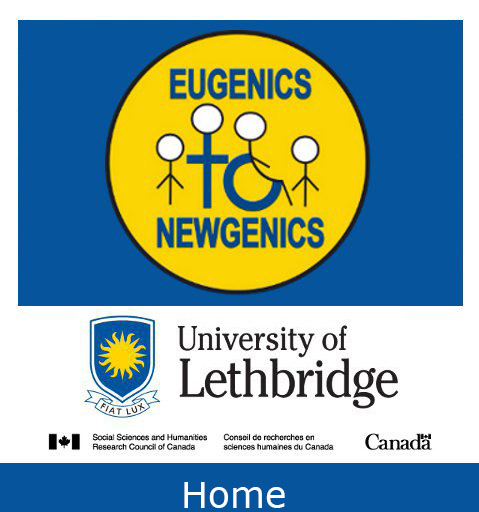What is Newgenics?
 Newgenics describes a broad range of medical, political and social practices related to ‘improving’ human kind on the one hand, and erasing disability and difference on the other.
Newgenics describes a broad range of medical, political and social practices related to ‘improving’ human kind on the one hand, and erasing disability and difference on the other.
The repeal of the Sexual Sterilization Act in 1972 saw the official end of negative eugenics in Alberta. Further, the Canadian Supreme Court ruling on Eve’s Law in 1986 made it illegal to involuntarily sterilize people anywhere in Canada. Passive eugenics in the form of large institutions are no longer common. However, efforts to control the sexuality and reproduction of disabled people, who are often seen as ‘unfit’ to parent, are now accomplished through less obvious, but far more invasive neo-eugenic and newgenic forms.
Eugenics is strongly associated with the late 19th through to the mid-20th century. However, neo-eugenics (often also called Liberal Eugenics) continues to carry the political torch for efforts to ‘improve’ the human race through biomedical means [1]. Neo-eugenics includes things like genetic prenatal testing and selective abortion [2], preimplantation genetic diagnosis, and posthumanist attempts to improve existing humans through biotechnologies [3]. These biomedical and biotechnological forms of neo-eugenics have often been critiqued as politically conservative and potentially harmful to disability acceptance and disability rights [4-6].
Newgenics moves beyond biological and medical interventions, to encompass systematic barriers to education, services, policy and supports for disabled people in terms of sexuality and reproduction. For example, a lack of information about sexuality, the ‘preventative’ use  of long-term birth control [4, 7, 8], or the automatic removal of children from disabled parents who are believed to be incompetent simply because of their disabilities [9], are all forms of newgenics. A pernicious form of newgenics is reflected in the reality that when people with disabilities do become parents, they receive very little support and can face high risks of child removal through family courts, due to perceptions that they are unfit to parent [10, 11]. Finally, Canadian immigration law remains strongly opposed to permitting disabled people to enter the country [12]. These practices reflect that idea that the sexuality and reproductive capacity of intellectually disabled, mad, or physically disabled people is dangerous and therefore in need of management.
of long-term birth control [4, 7, 8], or the automatic removal of children from disabled parents who are believed to be incompetent simply because of their disabilities [9], are all forms of newgenics. A pernicious form of newgenics is reflected in the reality that when people with disabilities do become parents, they receive very little support and can face high risks of child removal through family courts, due to perceptions that they are unfit to parent [10, 11]. Finally, Canadian immigration law remains strongly opposed to permitting disabled people to enter the country [12]. These practices reflect that idea that the sexuality and reproductive capacity of intellectually disabled, mad, or physically disabled people is dangerous and therefore in need of management.
Newgenics can take overt and covert forms. Overt forms of newgenics are things like disability homecare policies that ignore disabled people’s parenting roles, or group home rules that prevent disabled people from dating or having sexual partners. Covert forms of newgenics are less obvious, and include things like social stigmas, prevailing attitudes about disability and sexuality, and a lack of policy that recognizes or facilitates disabled people’s sexuality and relationships.
- Agar, N., Liberal Eugenics: In Defence of Human Enhancement. 2004, Oxford, England: Blackwell Publishing.
- Sexton, M., Why members of the Disability Community Oppose Prenatal Diagnosis and Selective Abortion, in Prenatal testing and Disability Rights, E. Parens and A. Asch, Editors. 2000, Gerogetown University Press: Washington, D.C. p. 147-164.
- Miller, S., Human, Transhuman, Posthuman: What’s the Difference and Who Cares? Futures Research Quarterly, 2004. 20(2): p. 61-67.
- Hampton, S.J., Family eugenics. Disability & Society, 2005. 20(5): p. 553-561.
- Parens, E. and A. Asch, The Disability Rights Critique of Prenatal Genetic Testing: Reflections and Recommendations, in Prenatal Testing and Disability Rights, E. Parens and A. Asch, Editors. 2000, Georgetown Universssity Press: Washington, D.C. p. 3-43.
- Tremain, S., Reproductive freedom, self-regulation, and the government of impairment in utero. Hypatia, 2006. 21(1): p. 35-53.
- Carlson, G., M. Taylor, and J. Wilson, Sterilisation, Drugs Which Suppress Sexual Drive, And Young Men Who Have Intellectual Disability. Journal of Intellectual & Developmental Disability, 2000. 25(2): p. 91-102.
- Aunos, M. and M.A. Feldman, Attitudes towards Sexuality, Sterilization and Parenting Rights of Persons with Intellectual Disabilities. Journal of Applied Research in Intellectual Disabilities, 2002. 15: p. 285-296.
- McConnell, D. and G. Llewellyn, Parental Disability and the Threat of Child Removal. Family Matters, 1998. 51(Spring/Summer): p. 33-36.
- Booth, T., W. Booth, and D. McConnell, The Prevalence and Outcomes of Care Proceedings Involving Parents with Learning Difficulties in the Family Courts. Journal of Applied Research in Intellectual Disabilities, 2005. 18: p. 7-17.
- Breeden, C., R. Olkin, and D.J. Taube, Child Custody Evaluations When One Divorcing Parent Has a Physical Disability. Rehabilitation Psychology, 2008. 53(4): p. 445-455.
- Roy, H. None is Still Too Many: An Historical Exploration of Canadian Immigration Legislation As It Pertains to People with Disabilities 2011; Available from: http://www.ccdonline.ca/en/socialpolicy/access-inclusion/none-still-too-many

[…] jot down my thoughts after reading pages 274-275, which is one of several times that eugenics and newgenics are […]